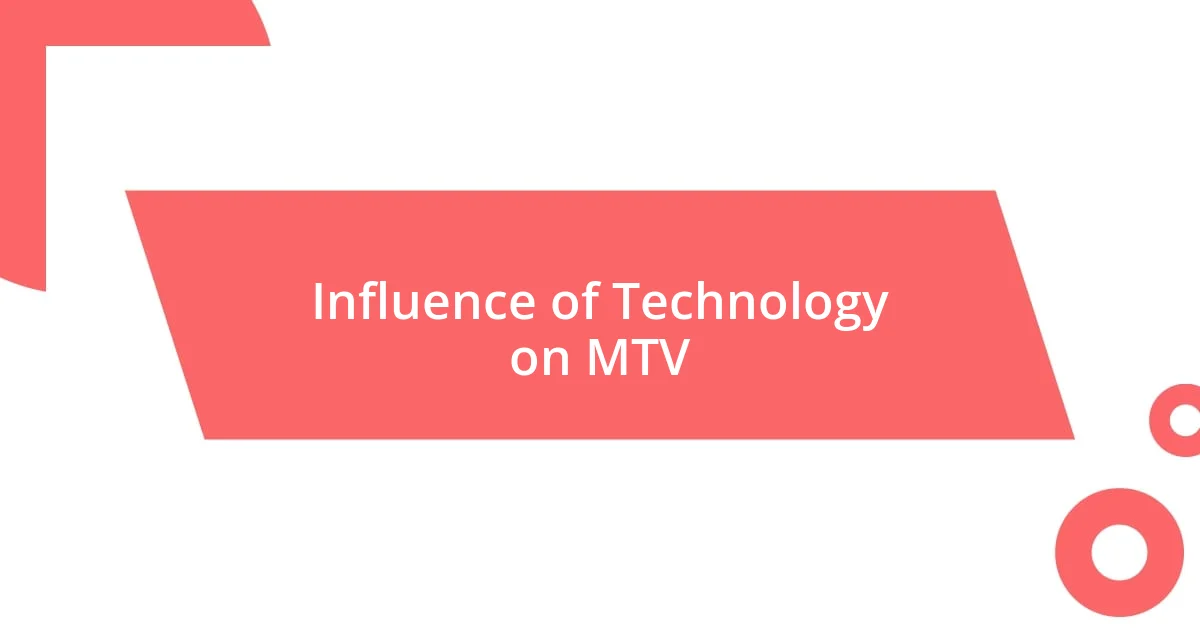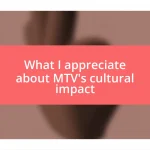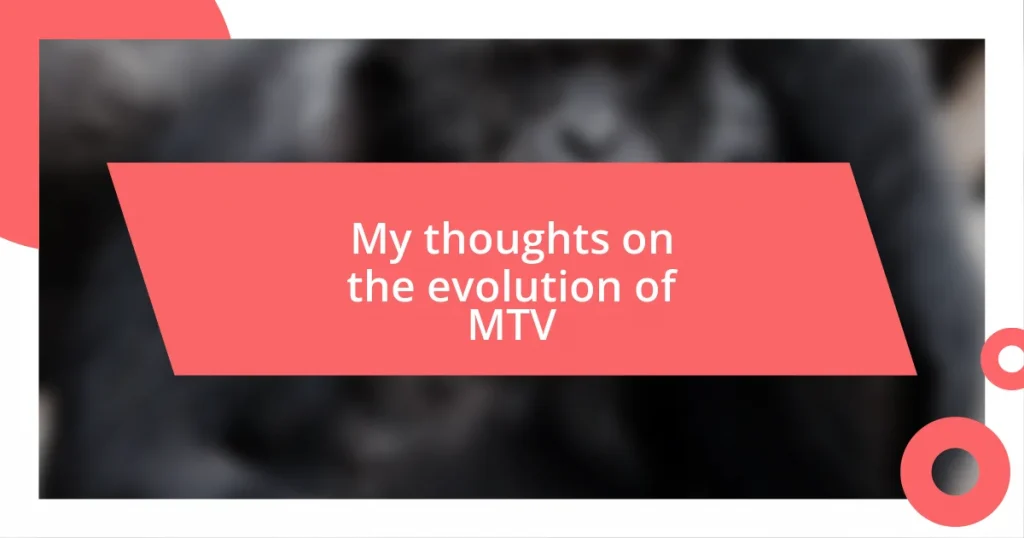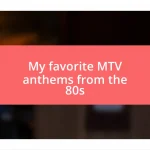Key takeaways:
- MTV launched on August 1, 1981, revolutionizing music consumption by combining music videos with visual storytelling, creating a sense of community among viewers.
- The channel evolved from solely airing music videos to incorporating reality shows and talent competitions, reshaping pop culture and audience engagement.
- Technological advancements, including the rise of the internet and social media, transformed MTV’s influence in music and culture, allowing more diverse voices and direct artist-audience connections.

Introduction to MTV’s History
MTV burst onto the scene on August 1, 1981, revolutionizing the way we consumed music. I remember the first time I tuned in—it felt like stepping into a vibrant world where music and visual art collided in electrifying ways. Can you recall your favorite music video from back then? For me, it had to be Michael Jackson’s “Thriller,” which wasn’t just a song; it was a cinematic experience.
Initially, the channel was all about showcasing music videos, giving artists a platform to connect emotionally with viewers through storytelling and visual creativity. I often find myself reflecting on how MTV made us feel like part of a larger community, especially during those block party weekends when everyone would gather to watch the latest hits. Isn’t it fascinating how that sense of belonging was woven into the fabric of pop culture at the time?
As the years rolled on, MTV evolved beyond just music videos, influencing not only the music industry but also fashion, lifestyle, and even societal norms. It’s intriguing to see how a channel that started with an anthem about video killed the radio star shifted gears to give us reality shows and cultural commentary. What were your thoughts on that transition? Personally, while I appreciated the variety, I sometimes missed those pure music moments that first drew us in.

Early Years of MTV
The early years of MTV were truly groundbreaking. The channel’s launch brought a fresh, dynamic way for music to be experienced visually. I vividly remember watching “Video Music Awards” in those days, where the creativity of artists shined through not just in the music but in elaborate visuals and storytelling. It wasn’t just about listening to songs anymore; it felt like a complete experience that engaged all my senses.
In those formative years, MTV became a cultural phenomenon. I often joined my friends after school to watch our favorite videos, sharing laughs and our reactions. That shared experience formed bonds that felt unique, rooted in the music and visuals we loved. It was exciting to see our idols come to life on screen, making us feel connected to them, almost as if they were right in our living rooms.
The programming back then was focused on music, showcasing a range of genres that appealed widely. I remember eagerly anticipating the countdowns—those moments felt like a celebration as we watched our favorites climb the charts. Now thinking back, I can clearly see how MTV was not just a channel; it was a cultural force that opened doors for artists and reshaped how we experienced music.
| Year | Key Event |
|---|---|
| 1981 | Launch of MTV |
| 1983 | First Video Music Awards |
| 1984 | Popularization of music videos |
| 1985 | Introduction of diverse genres |

MTV’s Impact on Music Culture
MTV dramatically shaped music culture, creating a new landscape where visuals were as important as sound. I remember when everyone at school would rush to discuss the latest music video premiere the next day. It was as if these videos had their own stories, captivating us in ways that transcended the audio alone. The art of storytelling through music videos became a craft in itself, influencing countless artists who realized that their songs could evoke powerful emotions through vivid visuals.
- MTV introduced global icons like Madonna and Michael Jackson, who utilized the platform to elevate their artistry.
- The channel’s “Unplugged” series redefined how we perceived live music, showcasing artists in a more intimate, personal light.
- By featuring diverse genres, MTV broadened our musical horizons, allowing mainstream access to alternative and underground artists.
- The impact of heavy rotation on the network often turned new or lesser-known songs into overnight sensations, changing the careers of countless musicians.
Though MTV has transformed radically over the years, I still feel nostalgic about how it brought us together, blending our musical tastes with visual extravagance. There was an excitement in discovering a new favorite song while catching up with friends, creating memories tied to both the music and the images that defined our youth.

Evolution of MTV Programming
MTV’s programming has shifted dramatically since those early days, reflecting changing audience tastes and cultural trends. I remember the day when reality TV took center stage with shows like “The Real World” and “The Osbournes.” It felt like a departure from the music videos I cherished, yet it created a new form of engagement that offered an unfiltered look into lives and relationships—something that was intriguingly real and relatable.
As the 2000s rolled in, MTV’s programming embraced a wider array of content, exploring genres and themes beyond music. I found myself intrigued by the introduction of talent competitions like “Making the Band” and “American Idol” that turned aspiring singers into household names almost overnight. It made me ponder how reality TV not only showcased talent but also shaped the future of pop culture, drawing in young audiences eager to see their dreams unfold in real time.
Today, I see MTV as a blend of nostalgia and innovation. While it still dips into music, the vast array of shows often leaves me wondering: does the channel still cater to music lovers? Or has it transformed into more of a lifestyle brand? Personally, I miss those music-filled days, but I also acknowledge the necessity of adaptation in an ever-evolving media landscape. The evolution has surely broadened the conversation about what entertainment can be, but there’s a part of me that longs for the former simplicity of just enjoying great music and visuals.

Influence of Technology on MTV
The technological advancements behind MTV’s rise are fascinating to consider. I still remember the thrill of watching music videos on a cathode-ray television, where every pixel felt like a special moment. The introduction of more sophisticated video editing and special effects transformed how artists expressed their music, creating mini-movies that captivated viewers like me and left a lasting imprint on our memories.
As the internet began to shape how we consume content, MTV had to adapt. I recall the day when I could stream music videos online, and it felt revolutionary. Suddenly, I wasn’t waiting for my favorite videos to air during a specific time slot; I could watch them whenever I wanted. This shift not only changed how MTV showcased artists but also empowered musicians to release their videos independently. The access to such platforms led to a more diverse range of voices and styles—how exciting it was to discover new talent that might never have appeared on traditional television!
Moreover, social media changed the game entirely. I often think about how artists routinely engage with their fans on platforms like Instagram or TikTok now. It’s a stark contrast to the one-way communication that characterized the early MTV days. I feel it’s wonderful yet overwhelming—artists are building their own narratives and connecting directly with audiences. Isn’t it remarkable how technology has democratized music and video production? Personally, I love seeing how creativity flourishes in this new environment, although I sometimes miss the curated experience that once defined MTV.

MTV’s Role in Pop Culture
MTV’s role in pop culture has been monumental, serving not only as a platform for music but as a catalyst for broader cultural conversations. I distinctly remember how the iconic “Moonman” award became a symbol of artistic achievement, making each MTV Video Music Awards night feel like a cultural milestone. Those moments weren’t just about the music; they sparked discussions about identity, style, and societal changes that resonated with us all.
Looking back, I can’t help but think about how MTV practically defined youth culture in the ’80s and ’90s. The channel wasn’t just showcasing music; it was curating an entire lifestyle. I recall rushing home from school to catch “Total Request Live” and feel like I was part of a community that shared the same passion for the latest hits and fashion trends. It wasn’t just about the videos; it was about being connected to something larger than ourselves, which created an exciting collective identity.
Now, as I reflect on MTV’s legacy, it’s interesting to consider its ongoing influence. Do we still see echoes of what MTV did for music and culture in today’s streaming platforms? I think we do, but in different forms. While the channel has departed from its roots, the essence of what it represented—celebrating creativity and fostering connection—remains crucial in today’s digital landscape. MTV may have evolved, but its impact on shaping pop culture and giving voice to new generations continues to be felt in various ways.














